Just a few days after I landed in London, Banksy kicked off his latest street art series, Banksy’s London Zoo (also known as Banksy’s Urban Safari), featuring wild animals stenciled across various corners of the city.
On the first day, I excitedly headed to Richmond to see the mountain gazelle, and rushed back home to blog about it. This was the first time I had the chance to witness a Banksy piece right after its unveiling, before any protective measures were put in place (that particular piece, for instance, has since been covered in Perspex, making it much harder to photograph), and I felt incredibly lucky to experience this coincidence. Little did I know, Banksy would continue to leave his mark on the streets of London for eight more consecutive days!
…and what an incredible journey it’s been! I’ve captured the excitement and thrill of this day-by-day adventure in a series of vlogs now available on YouTube: (start watching from the first episode!)
In this article, however, I want to delve deeper into Banksy’s London Zoo street art series, exploring the meaning of it, sharing insights on what happens when a new Banksy artwork is unveiled, and offering some thoughts on the ongoing debate about who owns the right to display—or displace—these pieces. (I plan to dive even deeper into the topic of copyright law and street art in my September 1st’s newsletter, so stay tuned!)
So, without further ado, let’s explore Banksy’s latest street art series in London.
- Read also: Where to Find Banksy’s Street Art in London
Understanding Banksy’s London Zoo Series: What Do the Animal Stencils Mean?
If you’ve read my article on Banksy’s mountain gazelle at Kew Gardens or watched the first episode of my YouTube series on Banksy’s London Zoo, you’ll know that when the first piece of Banksy’s London Zoo street art series was unveiled, everyone immediately searched for a deep, political meaning—something Banksy is renowned for in his stencil art. Whether you interpret Banksy’s first street art piece as a mountain gazelle (Palestine’s national animal) or as a goat (possibly referencing the Black Goat Act imposed by the Israeli government in 1950, which criminalized the herding of goats in Palestine), the message seemed clear.
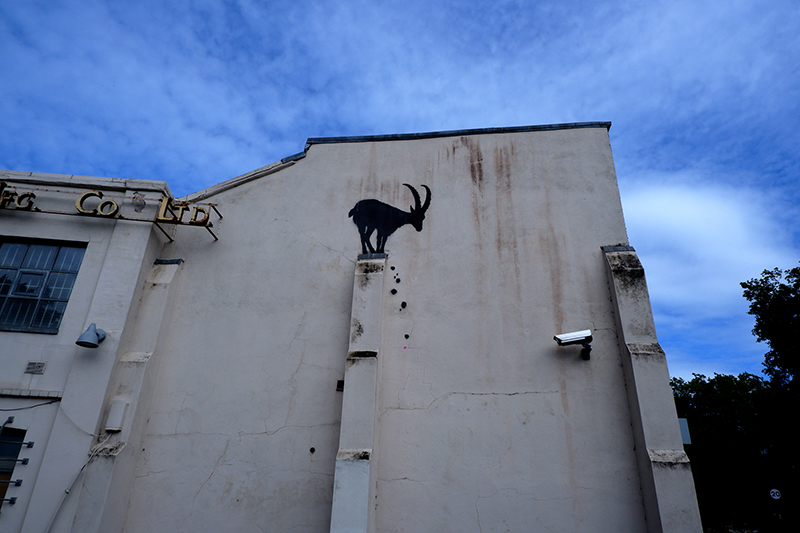
However, as more pieces from Banksy’s London Zoo series appeared across London, it became increasingly difficult to pinpoint specific meanings or references in them. Honestly, it started to feel like we were grasping at straws. Even Banksy himself chimed in later in the week, hinting that we might be overanalyzing his work—suggesting that these animal paintings were simply just that: animals. (It all eventually made sense with the unveiling of the final piece, which depicted a gorilla freeing these animals from a shutter at the London Zoo—but at the time, we had no way of knowing that.)
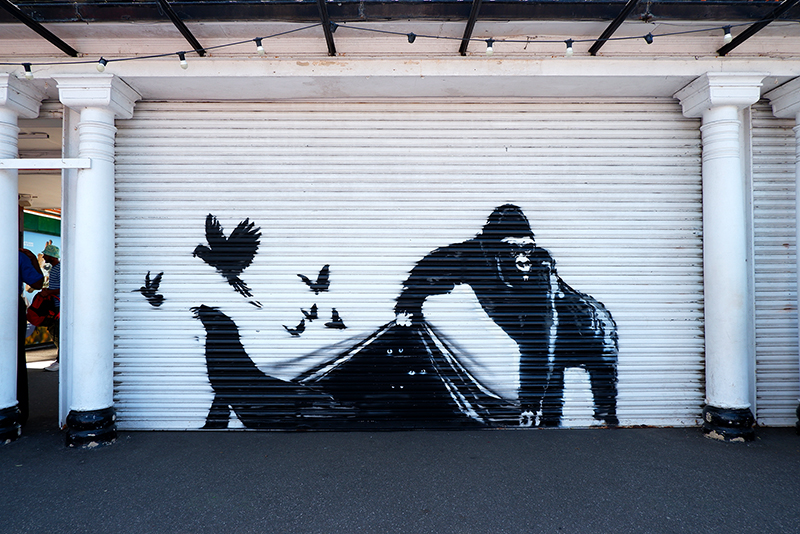
Rewilding the City Through Street Art: Banksy’s Urban Jungle
The sight of animals roaming freely across London immediately brought to mind the concept of rewilding the city. This idea revolves around bringing nature back into urban environments, challenging the dominance of concrete and steel with the organic beauty of the natural world. Banksy’s London Zoo series seems to resonate with this theme, using his signature stencil art to place wild animals in the heart of London—the ultimate concrete jungle.
Rewilding typically involves the restoration of natural habitats, allowing flora and fauna to reclaim areas overtaken by human development. In an urban setting, rewilding can take many forms, including the resurgence of unsanctioned art, harkening back to the roots of the street art movement. Banksy’s nocturnal, illicit creations can be seen as symbolic acts of reintroducing the wild into the city’s landscape, encouraging us to rethink how we coexist with nature in urban spaces.
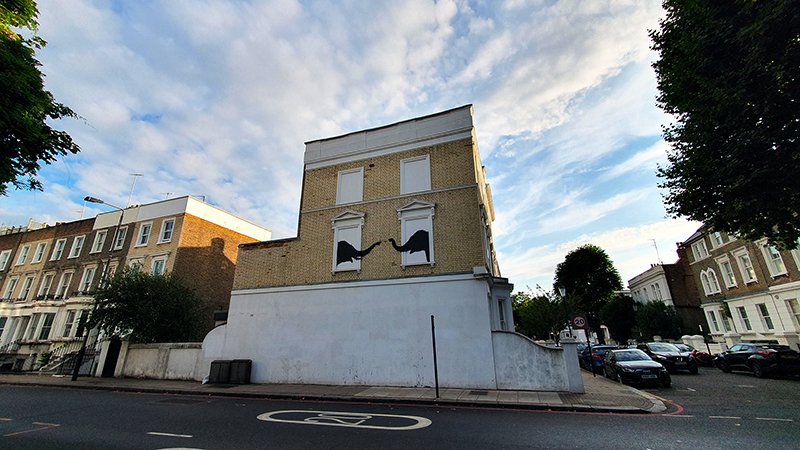
By bringing these animals to life on the streets of London, Banksy might be pushing us to think about the impact of urbanization and the disconnection from nature it often brings. His stencils could be seen as a call to action, urging city dwellers to consider the possibilities of making urban spaces more hospitable to wildlife, even if just symbolically through art.
Moreover, the choice of animals in his London Zoo series may hint at the resilience and adaptability of nature. Despite the concrete jungles we’ve built, nature finds ways to creep back in—whether through actual green spaces or through the artistic reimagining of these spaces. Banksy’s art encourages us to question the balance between the man-made and the natural, suggesting that perhaps, even in the most urban of environments, there’s room to “rewild” and reconnect with the natural world.
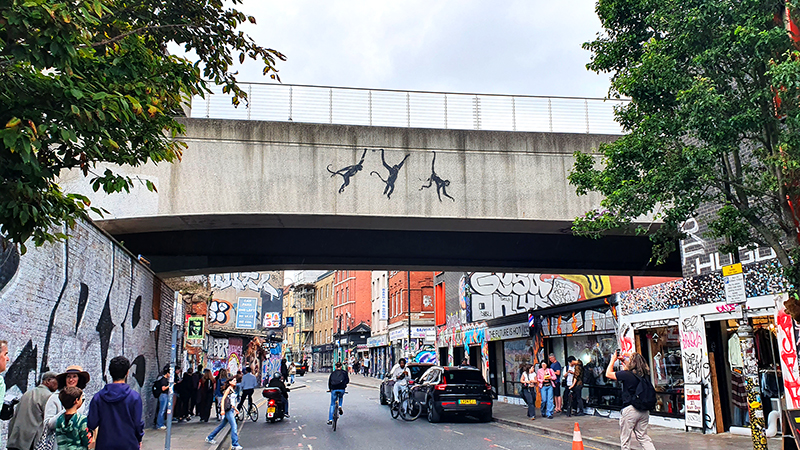
Through street art, the concept of rewilding becomes not just a physical transformation but also a mental and cultural shift, reminding us of the wildness that lies just beneath the surface of our urban lives. Banksy’s London Zoo series serves as a powerful reminder that the city is not just a habitat for humans but also a place where the spirit of the wild can, and should, thrive.
Banksy’s London Zoo Series: A Call to Rewild an Artform That’s Lost Its Wildness
The concept of street art as a form of truly free expression has always been central to its identity. Just as the gorilla in Banksy’s final piece is liberating the animals from the zoo, early street art pioneers like Banksy himself sought to free art from the constraints of galleries and museums.
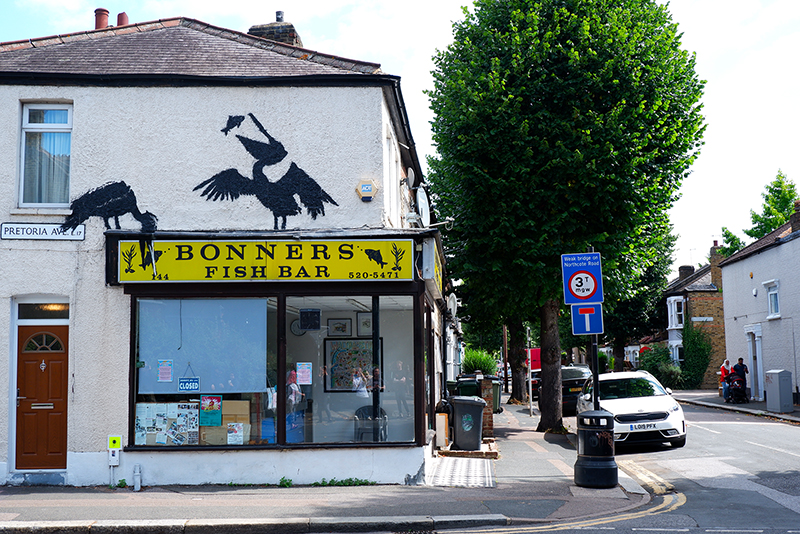
However, fast forward 40 years, and this art form, which was born out of rebellion and a desire to remain unsanctioned and wild, has become increasingly regulated. What once thrived on the fringes of society, as an act of defiance against the establishment, is now often curated, protected, and even commodified.
Over time, the very essence of street art has shifted. Originally a raw and unsanctioned form of expression, street art was created outside the boundaries of the traditional art world. It was spontaneous, often illegal, and always accessible to the public. But as the popularity of street art grew, so too did the forces seeking to control it. Cities began designating legal spaces for murals, requiring permits, and even commissioning street art as part of urban renewal projects. What was once an act of rebellion has become, in many cases, a part of the urban planning process.
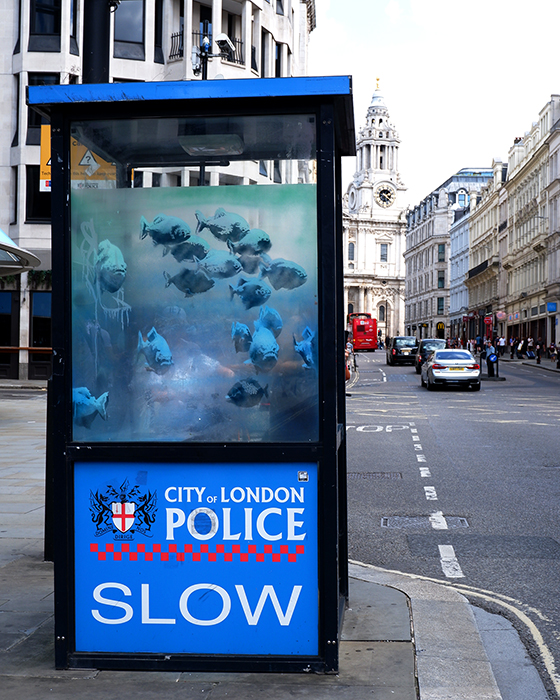
Yet, despite this shift, Banksy’s work continues to challenge the boundaries of what art can be and where it can exist. Through his London Zoo series, he reminds us of the original spirit of street art—its power to break free from conventional spaces and bring art directly to the people, in the most unexpected places. Just as the gorilla sets the animals loose, Banksy’s stencils set art free from its traditional constraints, rewilding not just the urban landscape but the very concept of art itself.
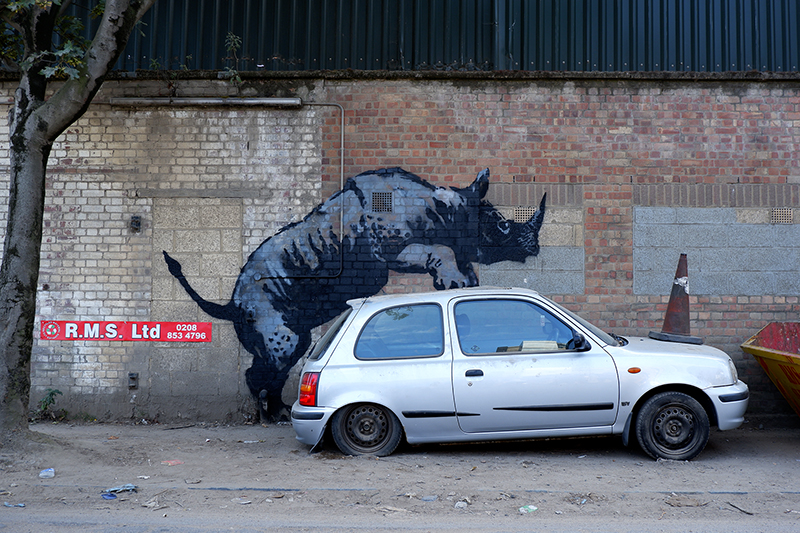
Did Banksy Collaborate with London Zoo? Unpacking the Controversy
Although Banksy’s London Zoo series showcases how street art can still break free from its chains, there’s one aspect that leaves me puzzled: the potential collaboration with the London Zoo. We can’t know for sure whether this operation was orchestrated or if the zoo staff were completely in the dark, but in the end, it doesn’t really matter. Even if the piece on the zoo’s gift shop shutter was created without any permissions, the fact remains that this artwork—on a perfectly removable surface, much easier to move than a wall—is worth hundreds of thousands of pounds, and Banksy must be well aware of that.
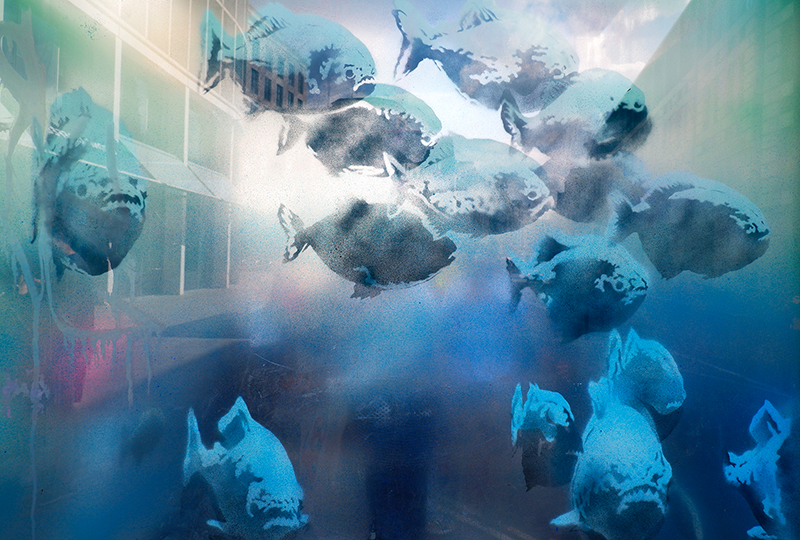
Essentially, Banksy has given the London Zoo a very valuable gift, and initially, this felt like a bit of a paradox to me. As a vegetarian, I’m used to viewing zoos as places where animals are kept in captivity. However, when I raised this concern with the locals—who by then had become my close friends after spending so much time together in front of the walls, sharing this incredible 9-day adventure—they reassured me. The Londoners told me that the London Zoo has an excellent reputation for its conservation efforts.
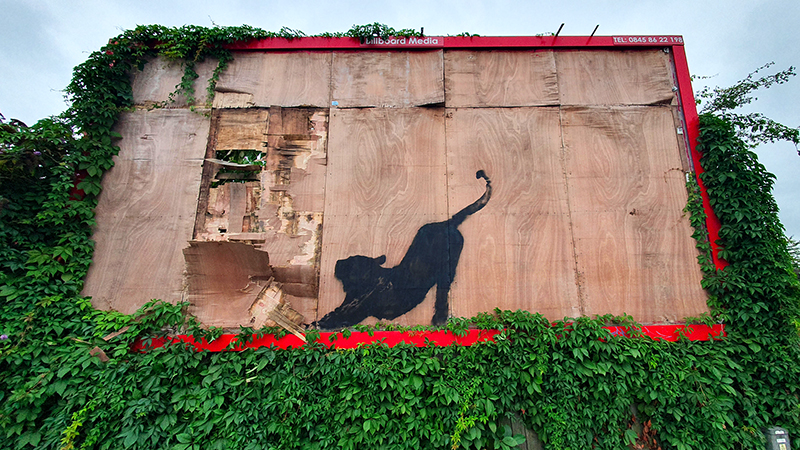
This got me thinking about Louis Masai, a street artist known for his environmental activism, who has previously collaborated with the London Zoo. In fact, three of his works are located on the same street as Banksy’s piece, just a five-minute walk towards Regent’s Canal.
My friend and fellow street art blogger Stuart also mentioned another street artist deeply committed to environmental causes who has collaborated with this zoo in the past, Jane Mutiny. So, it seems that this apparent contradiction doesn’t hold when it comes to the London Zoo. They may eventually choose to auction off Banksy’s piece or use it for fundraising activities, channeling the proceeds into good causes. Given that all the locals emphasized the zoo’s admirable ethics, who am I to argue with them?
The Fate of Banksy’s London Zoo Pieces: Ownership, Removal and the Battle for Public Art
This brings us to my next point: how Banksy’s pieces are “used” and, more importantly, who has the right to make those decisions and why. Banksy’s London Zoo series has served as a fascinating case study for me, as it’s the first time I’ve been able to witness firsthand what happens to a Banksy piece right after it’s unveiled. Each animal in the series has faced a different fate, representing a broad spectrum of outcomes. It quickly became clear that the “destiny” of each piece depended on the type of surface it was created on (i.e., how easy it is to remove it from its original context) and who legally owns that surface—therefore, who could claim rights over the artwork.
As of this writing, the only piece that remains intact, exactly as Banksy intended, is the trio of monkeys swinging along a bridge in East London. These monkeys are spray-painted on concrete, which makes them difficult to remove, and the support—the bridge—is owned by the city, as it serves as a track for London’s overground trains. This combination has proven to be ideal, as everything is still in place, and the monkeys are high enough that no one has defaced them (yet).
At the opposite end of the spectrum is the wolf: spray-painted on a satellite dish on the roof of a single-story building, it was stolen within an hour by three hooded individuals who are likely trying to sell it on the black market. Perhaps sooner or later, you’ll see it pop up in one of those endless, awful Banksy exhibitions—tourist traps that have been popping up around the globe and aren’t authorized by the artist, so you should definitely boycott them!
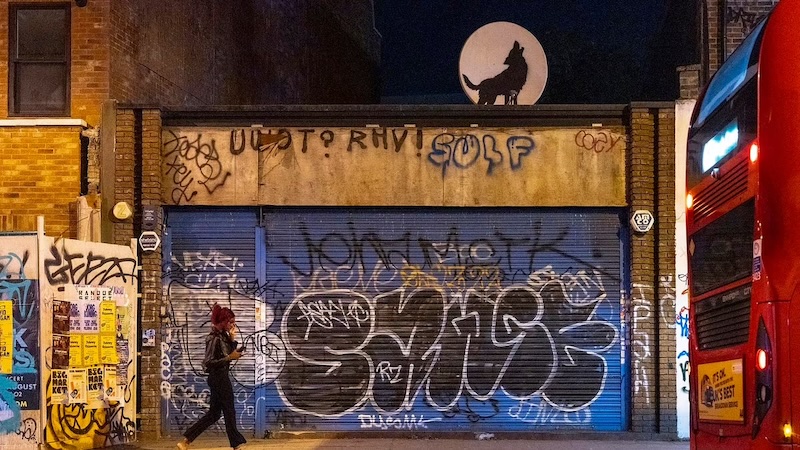
Another piece that will likely be sold off without much regard is the cat, which was stretching across the panels of a billboard not too far from where I’m staying. As soon as the billboard company recovered from the shock of receiving such an unexpected “gift,” they sent a contractor to remove the panels on which the artwork was painted, using the flimsy excuse that the panels were damaged and they were concerned about the safety of passersby.
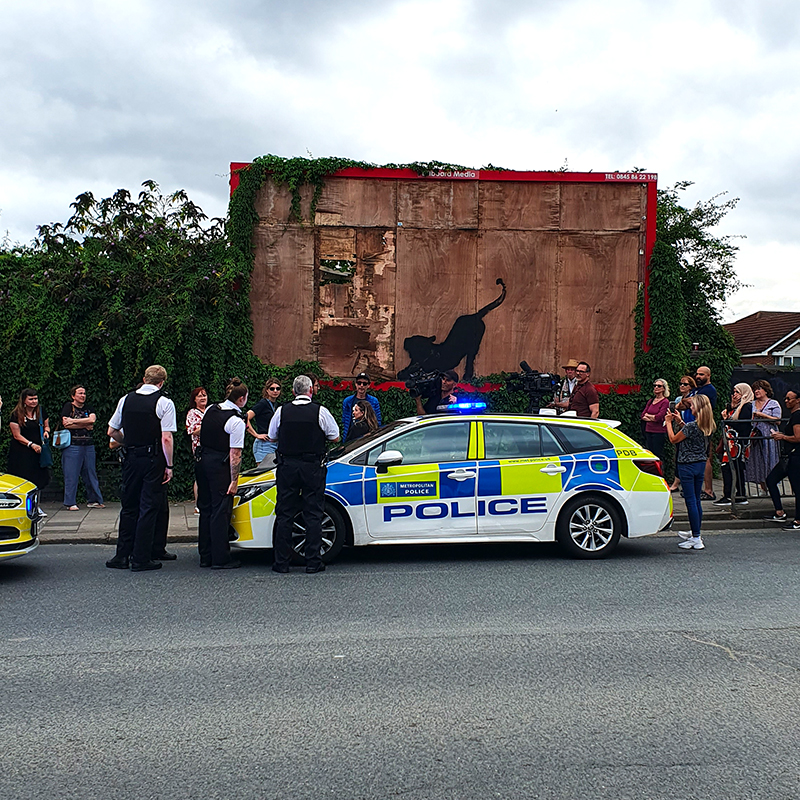
If you’ve seen my YouTube video, you already know that we tried everything we could to prevent the artwork from being taken out of public space, thus preventing others from enjoying it. Unfortunately, there was nothing we could do because the billboard company legally owns the surface, and they can do whatever they want with it—including selling it to the highest bidder. So, keep an eye out—this cat may soon appear in those exhibitions too.
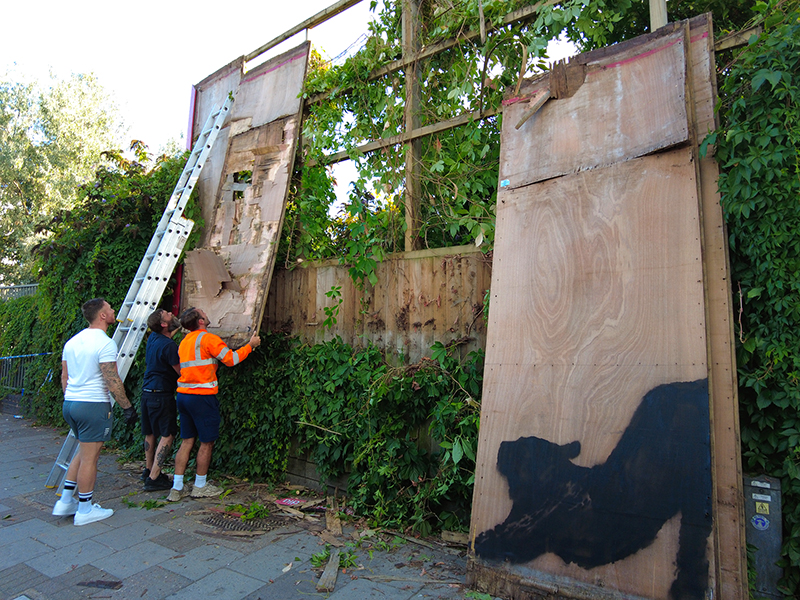
Another common scenario occurs when the owner of the surface is a private entity that, rather than exploiting the artwork, chooses to preserve it for the public to enjoy. In these cases, they often install Perspex or another type of protection to prevent the piece from being vandalized, painted over, or damaged. This is what happened to the mountain gazelle in Richmond, as well as many other Banksy pieces still visible in London.
- Read also: “Banksy and the Stolen Girl: Who Owns Street Art?“
This was also the intention for the rhino, but the installation of protection for the rhino piece wasn’t quick enough, and someone managed to spray over it. Additionally, the rhino lost key elements of the artwork—the smashed car and the traffic cone that served as its horn—rendering the piece less meaningful in its current state.
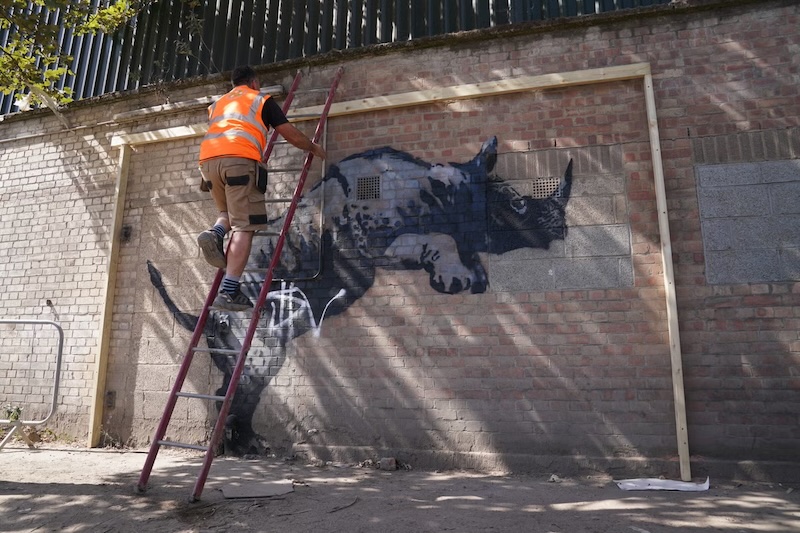
Similar interventions happened to the elephants—or rather, to one elephant, which has now been transformed into a zebra. Personally, I find this alteration amusing, and it highlights an important aspect of street art (and graffiti): it’s part of a continuous dialogue in public spaces, and this interaction is healthy and vital to the art form. I’m not opposed to anything that might happen to a Banksy piece, as long as it’s not about greedy individuals who steal an artwork from the community and sell it on the black market for profit.
Another possibility is that a Banksy piece becomes part of a museum collection (a legitimate museum, not those tacky “Banksy Museums” mentioned earlier). This is likely the fate of the piranha fish on the police box, my personal favorite from this series. The box has already been removed from the street (and by the way, the City of London created a very cinematic video about it, which is worth checking out).
Since the city council can’t sell it on the black market, it will probably be donated to a museum, allowing the public to continue enjoying it, albeit in a different context.
Finally, my favorite outcome—what I consider the happy ending—happens when a piece is embraced by the community, which then takes it upon themselves to protect it. This is the case with the pelicans in Walthamstow, painted on the sign of a beloved local shop. I’m not sure how the locals plan to keep it safe, but having witnessed the strong community spirit in Walthamstow (a neighborhood with its own street art community project, which I’ll be writing about soon), I’m confident in their genuine intention to preserve the artwork for everyone to enjoy. Their pride in being “chosen” by Banksy isn’t driven by greed, like the billboard company that immediately saw dollar signs, but by a sincere appreciation for the artistic value of the piece.
There’s still so much more to explore when it comes to the ownership and removal of public art, particularly if we extend the conversation beyond Banksy. This is a complex and ongoing debate that touches on the very nature of street art and its place in our urban landscapes. I’m planning to dive deeper into this topic in my September 1st newsletter, so if you’re interested in continuing this discussion, make sure you’re subscribed. Join the mailing list today to ensure you don’t miss out on this important conversation!